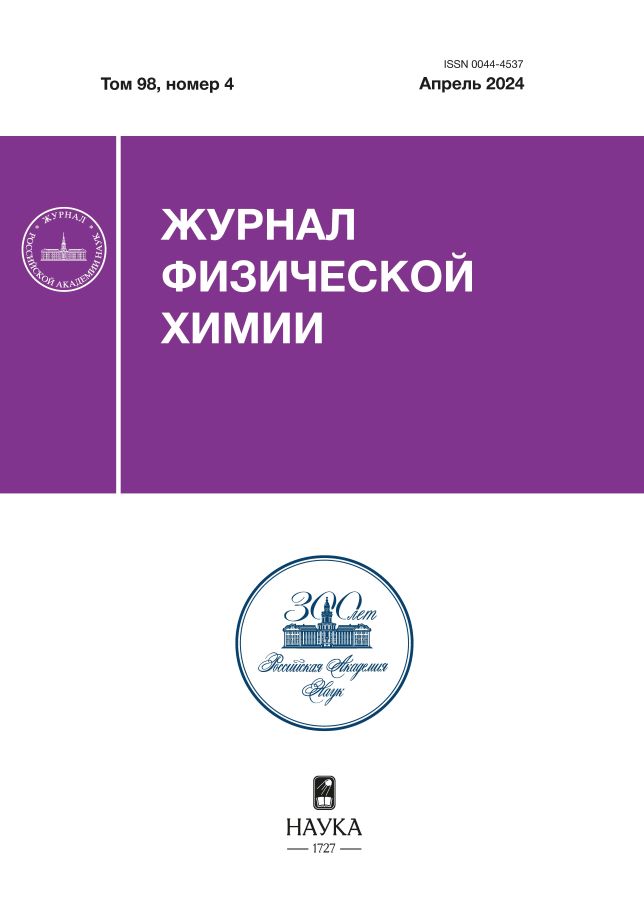Структура мезилатов пропил-, дипропил- и трипропиламмония по данным метода молекулярной динамики
- Autores: Федорова И.В.1, Крестьянинов М.А.1, Сафонова Л.П.1
-
Afiliações:
- Институт химии растворов им. Г.А. Крестова РАН
- Edição: Volume 98, Nº 4 (2024)
- Páginas: 64-73
- Seção: СТРОЕНИЕ ВЕЩЕСТВА И КВАНТОВАЯ ХИМИЯ
- ##submission.dateSubmitted##: 27.02.2025
- ##submission.datePublished##: 10.11.2024
- URL: https://permmedjournal.ru/0044-4537/article/view/668999
- DOI: https://doi.org/10.31857/S0044453724040085
- EDN: https://elibrary.ru/QEZCOS
- ID: 668999
Citar
Resumo
С использованием метода молекулярной динамики исследованы особенности формирования микроструктуры ионных жидкостей на основе мезилат аниона и катионов аммония, имеющих в составе различное число пропильных групп. Проанализированы структурные изменения жидкости при изменении размера катиона. Рассчитаны вероятности образования водородных связей между катионом и анионом и средние числа водородных связей. Рассмотрено влияние сольватационных эффектов на предсказанные ранее квантово-химическим методом структурные модели ионных жидкостей.
Palavras-chave
Texto integral
Sobre autores
И. Федорова
Институт химии растворов им. Г.А. Крестова РАН
Autor responsável pela correspondência
Email: fiv@isc-ras.ru
Rússia, Иваново
М. Крестьянинов
Институт химии растворов им. Г.А. Крестова РАН
Email: fiv@isc-ras.ru
Rússia, Иваново
Л. Сафонова
Институт химии растворов им. Г.А. Крестова РАН
Email: fiv@isc-ras.ru
Rússia, Иваново
Bibliografia
- Belieres J.P., Angell C. // J. Phys. Chem. B. 2007. V. 111. P. 4926. https://doi.org/10.1021/jp067589u
- Greaves T.L., Drummond C.J. // Chem. Rev. 2015. V. 115. P. 11379. https://doi.org/10.1021/acs.chemrev.5b00158
- Greaves T.L., Drummond C.J. // Ibid. 2008. V. 108. P. 206. https://doi.org/10.1021/cr068040u
- Hayes R., Warr G.G., Atkin R. // Ibid. 2015. V. 115. P. 6357. https://doi.org/10.1021/cr500411q
- Hayes R., Imberti S., Warr G.G., Atkin R. // Angew. Chem. Int. Ed. 2013. V. 52. P. 4623. https://doi.org/10.1002/anie.201209273
- Hunt P.A., Ashworth C.R., Matthews R.P. // Chem. Soc. Rev. 2015. V. 44. P. 1257. https://doi.org/10.1039/C4CS00278D
- Weingärtner H. // Angew. Chem. Int. Ed. 2008. V. 47. P. 654. https://doi.org/10.1002/anie.200604951
- Fumino K., Ludwig R. // J. Mol. Liq. 2014. V. 192. P. 94. http://doi.org/10.1016/j.molliq.2013.07.009
- Fumino K., Reimann S., Ludwig R. // Phys. Chem. Chem. Phys. 2014. V. 16. P. 21903. http://doi.org/10.1039/C4CP01476F
- Fumino K., Peppel T., Geppert-Rybczynska M. et al. // Ibid. 2011. V. 13. P. 14064. http://doi.org/10.1039/C1CP20732F
- Sun X., Cao B., Zhou X. et al. // J. Mol. Liq. 2016. V. 221. P. 254. https://doi.org/10.1016/j.molliq.2016.05.080
- Bodo E., Bonomo M., Mariani A. // J. Phys. Chem. B. 2021. V. 125. P. 2781. https://doi.org/10.1021/acs.jpcb.1c00249
- Han J., Wang L., Zhang H. et al. // J. Phys. Chem. A. 2020. V. 124. P. 10246. https://doi.org/10.1021/acs.jpca.0c07908
- Verma P.L., Gejji S.P. // J. Mol. Graph. Model. 2018. V. 85. P. 304. https://doi.org/10.1016/j.jmgm.2018.09.010
- Verma P.L., Gejji S.P. // J. Phys. Chem. A. 2018. V. 122. P. 6225. https://doi.org/10.1021/acs.jpca.8b04303
- Wei Y., Xu T., Zhang X. et al. // J. Chem. Eng. Data. 2018. V. 63. P. 4475. https://doi.org/10.1021/acs.jced.8b00583
- Fedorova I.V., Safonova L.P. // J. Phys. Chem. A 2019. V. 123. P. 293. https://doi.org/10.1021/acs.jpca.8b10906
- Fedorova I.V., Yablokov M.E., Safonova L.P. // Russ. J. Phys. Chem. A. 2022. V. 96. P. 2704. https://doi.org/10.1134/S003602442212010X
- Dong K., Zhang S., Wang Q. // Sci. China Chem. 2015. V. 58. P. 495. https://doi.org/10.1007/s11426-014-5147-2
- Shmukler L.E., Fedorova I.V., Fadeeva Yu.A., Safonova L.P. // J. Mol. Liq. 2021. V. 321. А. 114350. https://doi.org/10.1016/j.molliq.2020.114350
- Fabre E., Murshed S.M.S. // J. Mater. Chem. A. 2021. V. 9. P. 15861. https://doi.org/10.1039/d1ta03656d
- Abe H. // J. Mol. Liq. 2021. V. 332. А. 115189. https://doi.org/10.1016/j.molliq.2020.115189
- Markusson H., Belieres J. P., Johansson P. et al. // J. Phys. Chem. A. 2007. V. 111. P. 8717. https://doi.org/10.1021/jp072036k
- Fedorova I.V., Shmukler L.E., Fadeeva Yu.A. et al. // Russ. J. Phys. Chem. A. 2022. V. 96. P. 786. https://doi.org/10.1134/S0036024422040070
- Reid J.E.S.J., Bernardes C.E.S., Agapito F. et al. // Phys. Chem. Chem. Phys. 2017. V. 19. P. 28133. https://doi.org/10.1039/c7cp05076c
- Fedorova I.V., Shmukler L.E., Fadeeva Yu.A. et al. // Ionics. 2023. V. 29. P. 661. https://doi.org/10.1007/s11581-022-04844-5
- Fedorova I.V., Safonova L.P. // J. Mol. Model. 2023. V. 29. А. 230. https://doi.org/10.1007/s00894-023-05624-2
- Wang J., Wolf R.M., Caldwell J.W. et al. // J. Comput. Chem. 2004. V. 25. P. 1157. https://doi.org/10.1002/jcc.20035
- Wang J., Wang W., Kollman P.A., Case D.A. // J. Mol. Graph. Model. 2006. V. 25. P. 247. https://doi.org/10.1016/j.jmgm.2005.12.005
- Smith W., Yong C.W., Rodger P.M. // Mol. Simul. 2002. V. 28. P. 385. https://doi.org/10.1080/08927020290018769
- Singh U.C., Kollman P.A. // J. Comput. Chem. 1984. V. 5. P. 129. https://doi.org/10.1002/jcc.540050204
- Besler B.H., Merz Jr.K.M., Kollman P.A. // J. Comp. Chem. 1990. V. 11. P. 431. https://doi.org/10.1002/jcc.540110404
- Frisch M.J., Trucks G.W., Schlegel H.B. et al. Gaussian 09, Revision A.01, Gaussian, Inc., Wallingford CT, 2009.
- Smith W. // Comput. Phys. Commun. 1992. V. 67. P. 392. https://doi.org/10.1016/0010-4655(92)90048-4
- Youngs T.G.A. dlputils, Version 1.4.2. http://www.projectaten.com/dlputils
- Humphrey W., Dalke A., Schulten K. // J. Mol. Graph. 1996. V. 14. P. 33. https://doi.org/10.1016/0263-7855(96)00018-5
- Youngs T.G. // J. Comput. Chem. 2009. V. 31. P. 639. https://doi.org/10.1002/jcc.21359
- Bondi A. // J. Phys. Chem. 1964. V. 68. P. 441. https://doi.org/10.1021/j100785a001
- Arunan E., Desiraju G.R., Klein R.A. et al. // Pure Appl. Chem. 2011. V. 83. P. 1637. https://doi.org/10.1351/PAC-REC-10-01-02
- Fedorova I.V., Krestyaninov M.A., Safonova L.P. // Mol. Liq. 2022. V. 360. А. 119481. https://doi.org/10.1016/j.molliq.2022.119481
- Tsuzuki S., Shinoda W., Miran M.S. et al. // J. Chem. Phys. 2013. V. 139. А. 174504. https://doi.org/10.1063/1.4827519
Arquivos suplementares















